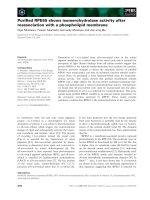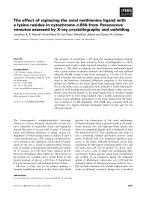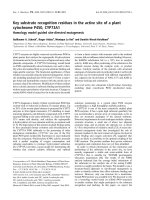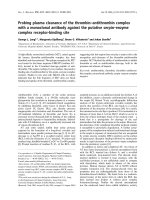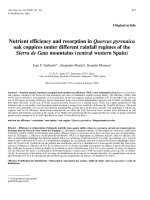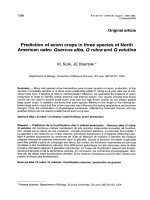Báo cáo khoa học: "Whole shoot hydraulic resistance in Quercus species measured with a new high-pressure flowmeter" pps
Bạn đang xem bản rút gọn của tài liệu. Xem và tải ngay bản đầy đủ của tài liệu tại đây (470.9 KB, 7 trang )
Original
article
Whole
shoot
hydraulic
resistance
in
Quercus
species
measured
with
a
new
high-pressure
flowmeter
MT
Tyree
B Sinclair
P Lu
A
Granier
3
1
US
Department
of Agriculture,
Forest
Service,
Northeastern
Forest
Experiment
Station,
PO
Box
968,
Burlington,
Vermont,
05402
USA;
2
INRA,
Laboratoire
de
Physiologie
Intégrée
de
l’Arbre
Fruitier,
63039
Clermont-Ferrand,
3
INRA,
Laboratoire
d’Écophysiologie
Forestière,
54280
Champenoux,
France
(Received
16
December
1992;
accepted
21
April 1993)
Summary —
Whole
shoot
resistance
to
water
flow
was
measured
in
4
species
of
oak,
Quercus
ro-
bur
L,
Q
petraea
Matt
Liebl,
Q
pubescens
Willd,
and
Q
rubra
L.
Shoots
were
1.1
to
1.5
m
long
with
16-19
mm
basal
wood
diameter
and
were
4-8
yr
old.
Whole
shoot
resistances
accounted
for
20-
40%
of
the
total
resistance
to
water
flow
from
soils
to
leaves
based
on
comparisons
with
literature
values.
Leaf
blade
resistances
accounted
for
80-90%
of
total
shoot
resistances
measured
in
this
study.
Stem
resistances
to
water
flow
were
≈ twice
as
large
in
Q
robur
than
in
the
other
species
which
had
comparable
stem
resistances.
Differences
in
shoot
resistance
between
Q
robur
versus
Q
petrae
are
discussed
in
terms
of
the
differential
response
of
these
species
to
drought
in
mixed
stands.
Quercus
/ hydraulic
resistance
I
water
stress
Résumé —
Mesure
de
la
résistance
au
transfert
de
l’eau
chez
différentes
espèces
de
chênes
au
moyen
d’un
nouveau
fluxmètre
haute
pression.
La
résistance
au
transfert
de
l’eau
de
branches
a
été
mesurée
chez
4
espèces
de
chênes :
Quercus
robur
L,
Q
petraea
Matt
Liebl,
Q
pu-
bescens
Willd
et Q
rubra
L.
Les
branches
avaient
une
longueur
comprise
entre
1,1
et
1,5
m,
pour
un
diamètre
de
16
à 19
mm
à leur
base,
et
étaient
âgées
de
4
à 8
ans.
La
comparaison
des
mesures
avec
des
données
de
la
littérature
a
montré
que
la
résistance
au
transfert
de
l’eau
dans
les
branches
était
de
l’ordre
de
20
à 40%
de
la
résistance
hydraulique
totale,
calculée
entre
le
sol
et
les
feuilles.
La
résistance
au
transfert
dans
les
feuilles
représentait
de
80
à
90%
de
la
résistance
totale
de
la
branche.
Les
résistances
dans
les
parties
ligneuses
étaient
environ
deux
fois
plus
élevées
chez
Q
robur
que
chez
les
autres
espèces,
celle-ci
montrant
des
valeurs
comparables.
Les
diffé-
rences
de
résistance
hydraulique
entre
Q
robur
et
Q
petraea
sont
discutées
en
termes
de
diffé-
rences
de
réponse
à
la
sécheresse
de
ces
espèces
dans
les
peuplements
mélangés.
Quercus
/
résistance
hydraulique
totale
/
résistance
au
transfert
de
l’eau
INTRODUCTION
Some
mid-European
oak
species
are
more
sensitive
to
drought
than
others.
Pre-
liminary
observations
have
shown
that
in
mixed
stands
of
Quercus
robur
and
Q
pe-
traea
only
the
former
species
was
in
de-
cline
following
the
exceptional
drought
that
occurred
in
France
in
1976
(Becker
and
Lévy,
1982).
Another
related
species,
Q
pubescens,
is
mostly
found
in
Southern
Europe
where
severe
drought
develops
every
summer.
So
taxa
of
subgenus
Le-
pidobalanus
section
robur
(Krussmann,
1978),
which
includes
all
the
above
spe-
cies,
exhibit
very
different
responses
to
water
stress.
Since
1976,
a
number
of
studies
have
been
undertaken
to
deter-
mine
the
mechanisms
of
this
difference
in
drought
resistance
but
no
striking
differ-
ences
have
yet
been
found
except
for
dif-
ferences
in
vulnerability
to
cavitation,
Q
robur
being
more
sensitive
to
drought-
induced
xylem
dysfunction
by
cavitation
than
Q
petraea
which
is
as
vulnerable
as
Q pubescens
(Cochard
et al,
1992).
Differences
in
hydraulic
architecture
of
trees
may
contribute
to
their
adaptation
to
drought
(Zimmermann
1983;
Tyree
and
Ewers
1991).
The
hydraulic
resistance
of
the
xylem
of
trees
will
determine,
in
part,
the
degree
of
water
stress
in
leaves
as
measured
by
xylem
pressure
potential,
ψ
xp
.
A
reduced
ψ
xp
(more
negative)
can
cause
reduced
cell
expansion,
wall
synthe-
sis,
protein
synthesis,
stomatal
conduc-
tance
and
photosynthesis
and
an
in-
creased
xylem
dysfunction
by
cavitation
events.
According
to
the
soil-plant-
atmosphere-continuum
model
of
water
flow
in
trees,
the
ψ
xp
of
leaves
will
be
de-
termined
by
the
soil
water
potential,
ψ
soil
,
the
hydraulic
resistances
of
the
root
and
shoot
(R
r
and
Rs,
respectively)
and
the
evaporative
flux
density
from
leaves,
E,
according
to
the
following
equation.
In
this
study,
we
have used
a
new
high-
pressure
flowmeter
to
make
rapid
compari-
sons
of
the
hydraulic
architecture
of
shoots
of
4
oak
species
(Q
robur,
Q
petraea,
Q
pubescens,
and
Q
rubra).
MATERIALS
AND
METHODS
Plant
material
Branches
of
Quercus
robur, Q
petraea,
Q
pu-
bescens,
and
Q
rubra
were
collected
from
Champenoux,
France
(16
km
east
of
Nancy)
from
the
same
trees
as
those
used
in
the
study
of
Cochard
et
al
(1992).
Branches
=
2 m
long
and
25
mm
in
diameter
at
the
base
were
cut
with
pole
pruners
from
the
south
side
of
mature
trees
in
a
sunny
location.
Within
5
min
the
branches
were
transported
back
to
the
labora-
tory
where
the
base
of
the
branch
was
placed
under
water
and
recut
=
0.3
m
from
the
base
to
remove
some
of
the
air
bubbles
sucked
into
the
stem
during
the
initial
cut.
Prior
to
connecting
shoots
to
the
high-
pressure
flowmeter
described
below,
all
cut
sur-
faces
were
shaved
with
a
razor
blade
to
remove
blockage
of
cut
vessels
by
cell-wall
fragments
formed
by
the
initial
cuts.
The
high-pressure
flowmeter
The
flowmeter
shown
in
figure
1
permitted
the
perfusion
of
water
into
the
base
of
a
branched
system
while
measuring
the
flow
rate
F (kg
s
-1).
The
main
body
of
the
system
was
constructed
from
glass
tubing,
tygon
tubing,
stopcocks,
and
plastic
T-junctions.
Water
was
held
in
a
flexible
plastic
bag
inside
a
pressure
reservoir
(R).
Wa-
ter
contained
in
the
reservoir
was
distilled
water
filtered
through
an
0.1
μm
filter.
The
water
was
placed
under
pressure
by
compressed
air,
con-
trolled
with
a
pressure
regulator
(PR)
using
gas
from
a
compressed-air
tank
(not
shown).
The
water
was
directed
through
a
capillary
tube
(CT,
0.7
mm
diameter
and
0.12
m
long)
and
then
onto
the
shoot.
The
rate
of
flow,
F,
across
the
CT
is
proportional
to
the
pressure
drop
across
the
tube;
this
pressure
drop
was
recorded
with
a
2-arm
water
manometer
system
made
from
thick-walled
glass
capillary
tubes
of
1.5
mm
in-
ternal
diameter.
The
water
level
in
the
right
arm
of
the
manometer
(MR)
was
always
at
the
same
level
as
the
water
in
the
reservoir
(R).
The
same
air
pressure
used
to
pressurize
water
in
the
reservoir
(R)
was
transmitted
to
the
top
of
the
right
and
left
manometer
columns
via
lengths
of
tygon
tubing.
This
prevented
the
water
in
the
right
arm
of
the
manometer
(MR)
from
rising
above
the
level
of
water
in
the
reservoir
when
the
water
was
under
pressure.
The
level
of
wa-
ter
in
the
left
arm
of
the
manometer
(ML)
de-
pended
on
the
rate
and
direction
of
flow
across
CT.
Usually,
flow
was
from
right
to
left
across
CT
(fig
1)
and
this
made
the
level
in
ML
below
that
in
MR.
To
facilitate
more
accurate
measure-
ment
of
the
height
difference,
Δh,
between
MR
and
ML,
a
water
level
(WL)
was
used
to
transfer
the
level of
water
from
MR
to
ML.
The
WL
con-
sisted
of
a
length
of
tygon
tubing
partly
filled
with
water.
The
position
of
the
tubing
was
ad-
justed
so
that
the
level
of
water
in
WL
coincided
with
that
in
MR;
the
Δh
could
be
measured
at
the
place
shown
in
figure
1.
Three-way
stop-
cocks
(S
1
and
S2)
were
used
to
fill
the
flowmeter
and
reservoir
with
water
and
S3
was
used
to
re-
lease
air
pressure
from
the
system.
The
flowmeter
was
calibrated
by
directing
flow
of
water
across
a
length
of
stem
segment
via water-filled
tubing
to
a
container
of
water
on
a
balance.
Flow
rate,
F,
was
adjusted
to
differ-
ent
values
by
changing
the
air
pressure
in
R and
measuring
the
rate
of
flow
(kg
s
-1
)
into
the
con-
tainer
of
water
on
the
balance.
Calibration
curves
were
linear
with
a
maximum
deviation
from
the
best
fit
straight
line
of
1.5%
full
scale.
The
differ-
ence
in
water
levels,
Δh,
was
rarely
0
at
F
=
0,
because
of
differences
in
surface
tension
of
wa-
ter
in
MR
and
ML.
The
height
difference
at
F
=
0
was
measured
and
subtracted
from
all
readings
(usually
a
correction
of
1-3
mm).
The
problem
of
a
non-zero
Δh
o
could
have
been
eliminated
by
replacing
the
manometer
columns
with
a
dif-
ferential
pressure
gauge
like
that
used
in
a
low-
pressure
flow
meter
described
by
Tyree
(1983).
However,
that
would
have
eliminated
the
main
advantages
of
the
present
high-pressure
flow
meter,
ie,
that
it
was
inexpensive
and
could
be
used
without
a
power
source
under
field
condi-
tions.
Measurement
of
shoot
resistances
Shoot
resistances
were
measured
by
connect-
ing
the
flowmeter
to
a
shoot
and
perfusing
water
at
0.2
MPa
pressure
for
2
or
3
h.
Initially,
flow
rate
was
high
but
declined
gradually.
The
initially
high
flow
rate
was
attributed
to
negative
leaf
wa-
ter
potentials,
ψ
leaf
However,
after
2
or
3
h
the
leaf
air
spaces
were
visibly
infiltrated
with
water
and
water
dripped
from
the
stomata
of
some
leaves
and
F
became
stable.
Shoot
resistance
was
computed
from:
where
P
was
the
applied
water
pressure,
and
A
was
the
total
leaf
area
of
the
shoots
measured
with
a
delta-T
leaf
area
meter
(Delta-T
Devices
Ltd,
Cambridge,
UK)
at
the
end
of
the
experi-
ment.
Normalization
of
Rs
by
multiplying
P/F
by
A
was
justified
because
preliminary
experiments
revealed
that
large
shoots
(with
large
A)
had
smaller
value
of
P/F
than
small
shoots;
see
Yang
and
Tyree
(1993)
for
a
discussion
of
how
P/F depends
on
branch
size
in
Acer saccharum.
Resistances
of
the
components
of
a
shoot
were
measured
by
making
resistance
measure-
ments
after
removal
of
each
component.
For
ex-
ample,
the
resistance
of
the
whole
shoot
was
measured
before
and
after
removal
of
leaf
blades.
Leaf-blade
resistance
was
calculated
from
Subsequently,
all
petioles
were
removed,
then
all
current-year
shoots,
then
all
1-yr-old
shoots,
etc.
Measurements
of
the
branch
resistance
be-
fore
and
after
each
removal
were
used
to
calcu-
late
resistances
of
each
component
by
differ-
ence.
All
values
were
normalized
by
multiplying
P/F by A.
RESULTS
Shoot
resistances
of
oak
were
measured
on
shoots
1.1-1.5
m
long
with
leaf
areas
of
1.1
to
2.1
m2
and
basal
diameters
of
16-19
mm.
The
shoots
ranged
in
age
from
4-8
yr.
Resistances
of
removed
compo-
nents
are
shown
in
figure
2A.
Leaf
blade
resistances
were >
20-fold
that
of
any
other
component
(eg,
petioles,
current-
year
shoots,
1-yr-old
shoots
etc).
The
leaf
blade
resistance
of
Q
pubescens
(2.42
±
0.12
x
10
4
MPa
s
m2
kg-1
)
was
significant-
ly
higher
(P
=
0.05)
than
that
of
the
other
species
which
were
not
significantly
differ-
ent
from
each
other
(1.82
±
0.12,
1.89
±
0.16,
2.04
±
0.07
x
10
4
for
Q
petraea,
Q
robur,
and
Q
rubra,
respectively).
Petioles
of
Q
robur
were
too
small
to
remove
sep-
arately,
but
the
petiole
resistances
of
all
other
species
were
significantly
less
than
that
from
the
current-year
shoots.
Petioles
were
removed
by
breaking
them
off
from
the
current-year
shoots.
They
broke
near
where
the
abscission
zone
would
have
formed
in
fall,
but
part
of
the
vascular
in-
sertion
zone
would
have
remained
behind
in
the
current-year
shoots.
Our
methods
did
not
permit
us
to
estimate
the
junction
constrictions
(if
any
were
present)
between
the
petioles
and
current-year
shoots.
There
was
a
general
trend
of
declining
stem
component
resistance
to
water
flow
with
increasing
age
of
the
stem.
In
figure
2B
the
data
are
replotted
to
show
the
shoot
resistance
remaining
after
removal
of
each
component
labelled
on
the
x-axis.
"W"
refers
to
the
whole-shoot
resistance
(with
leaves
present).
The
resis-
tance
for
"LB"
refers
to
the
resistance
re-
maining
after
removal
of
leaf
blades
(peti-
oles
and
all
stems
were
still
present).
"P"
refers
to
the
resistance
of
the
shoots
after
removal
of
the
petioles
(all
stems
were
still
present).
The
other
notations
on
the
x-axis
have
analogous
meanings.
The
percent-
age
of
the
whole
shoot
resistance
remain-
ing
after
removal
of
the
leaf
blades
was
8.7
± 0.3, 11.4 ± 1.6, 13.5 ± 1.5, and 18.5 ±
1.8
for
Q
pubescens,
Q
rubra,
Q
petraea,
and
Q
robur,
respectively.
Thus,
the
leaf-
blade
resistances
were
80-90%
of
the
whole-shoot
resistance.
DISCUSSION
The
leaf-blade
resistances
of
Quercus
(1.87
to
2.4
x
10
4
MPa
m2
s
kg-1
)
are
2-4
times
more
than
that
which
is
found
in
other
species
where
the values
range
from
0.5
to
1
x
10
4
MPa
m2
s
kg-1
for
Fagus
grandifolia
(Tyree
and
Cheung,
1977),
Ju-
glans
regia
(Tyree
et
al,
1993)
and
for
Acer
saccharum
and
Populus
deltoides
(Tyree
and
Alexander,
unpublished
data).
The
leaf-blade
resistance
includes
vascular
and
nonvascular
pathways
from
the
base
of
the
leaves
to
mesophyll
airspaces,
but
we
are
of
the
opinion
that
the
main
resis-
tance
to
water
flow
is
probably
in
the
non-
vascular
part
of
the
path
(Tyree
and
Cheung, 1977).
Leaf-blade
resistances
are
relevant
to
a
better
understanding
of
stomatal
physio-
logy
because
they
allow
us
to
estimate
gradient
in
water
potential
between
minor
veins
and
stomata,
ie,
leaf-blade resistanc-
es
can
be
used
to
predict
localized
stoma-
tal
desiccation.
Leaf
blade
resistances
were
very
high
when
considered
in
terms
of
the
water
potential
drop
that
would
oc-
cur
in
them
during
normal
transpiration.
Quercus
leaves
have
evaporative
flux
den-
sities
of
6
x
10-5
kg
s
-1
m
-2
at
midday
(Bré-
da and
Granier,
unpublished
data).
Ac-
cordingly
the
drop
in
ψ
from
the
base
of
the
blade
to
mesophyll
air
spaces
must
be
E•R
leaf
blade
=
0.87-1.45
MPa
for
Q
pubes-
cens
and
Q
petraea,
respectively,
with
the
other
2
species
within
the
above
range.
The
resistances
measured
in
this
paper
are
probably
about
the
same
as
or
less
than
the
resistance
encountered
by
water
during
normal
transpiration.
The
resistance
to
water
flow
in
Quercus
leaf
blades
could
be
higher
during
normal
transpiration
if
most
water
evaporation
occurs
near
the
stomata
in
accordance
with
the
evidence
in
support
of
peristomatal
evaporation
in
substomatal
cavities
(Tyree
and
Yianoulis,
1980;
Yianoulis
and
Tyree,
1984).
The
large
resistance
to
water
flow
in
leaves
would
cause
a
large
reduction
in
the
water
potential
of
the
guard
cells
of
stomata
and
could
account
for
the
partial
closure
of
stomata
around
midday
observed
in
many
Quercus
species
(Tenhunen
et
al,
1985;
Epron
et al,
1992).
One
of
the
objectives
of
this
study
was
to
see
if
we
could
find
further
physiological
evidence
for
Q
robur
being
more
in
decline
after
drought
episodes
than
Q
petraea.
Q
robur
is
more
vulnerable
to
cavitation
than
Q
petraea,
the
former
reaching
50%
loss
of
the
conductivity
in
petioles
and
current
year
stems
at
ψ
xp
=
-2.7
MPa
whereas
the
latter
did
not
reach
50%
loss
of
conductivi-
ty
until
ψ
xp
=
-3.3
MPa
(Cochard
et
al,
1992).
Evaporative
flux
densities,
E,
are
about
the
same
for
Q
robur
and
Q
petraea,
but
the
shoot
resistances
to
water
flow
are
1.5-
to
2-fold
higher
in
Q
robur
than
in
Q
petraea
(fig
3B).
This
difference
in
shoot
resistance
will
tend
to
make
stem ψ
s
more
negative
in
Q
robur
than
in
Q
petraea.
These
differences
in
shoot
resistance
and
in
vulnerability
to
cavitation
could
make
Q
robur
cavitate
earlier
in
a
drought
cycle
than
Q
petraea.
However,
it
is
difficult
to
say
if
the
observed
differences
in
shoot
re-
sistances
of
relatively
small
shoots
in
this
study
will
have
a
dominating
affect
on
field
performance
of
the
2
species
without
fur-
ther
knowledge
of
root
and
bole
resistanc-
es
of
the
2
species.
The
shoot
resistances
we
have
meas-
ured
are
only
a
small
fraction
of
the
sum
of
the resistances
in
the
soil,
root,
shoot
and
leaf
of
whole
trees
of
Quercus.
Whole
tree
resistances,
R
tree
,
have
been
estimated
for
Q
robur
and
Q
petraea
based
on
meas-
ures
of
predawn
water
potential
(as
an
es-
timate
of
ψ
soil
)
and
the
relatioship
between
ψ
leaf
and
stem
water
flow
under
well-
watered
conditions.
These
R
tree
values
are
in
the
range
of
5
to
10
x
10
4
MPa
s
m2
kg-
1
and do
not
vary
much
with
tree
size
(Cer-
mak
et al,
1980;
Bréda
et al,
1993;
Simo-
nin
et
al,
1993).
Accordingly,
the
shoot
re-
sistance
of
this
study
accounts
for
about
20-40%
of
the
resistance
of
the
entire
soil-plant
hydraulic
pathway.
In
a
study
on
leafless
shoots
of
Acer
saccharum,
≈ 50%
the
total
resistance
to
water
flow
in
shoots
0.12
m
in
diameter
at
the
base
is
con-
tained
in
branches
<
0.02
m
basal
diame-
ter
(Yang
and
Tyree,
1993).
If
the
same
pattern
holds
in
Quercus,
then
we
might
predict
that
30
or
50%
of
the
total
resis-
tance
to
water
flow
is
contained
in
the
above-ground
portion
of
trees
with
perhaps
80%
of
the
shoot
resistance
contained
in
the
leaf
blades.
The
remainder
of
the
whole
tree
resistance
to
water
flow
is
accounted
for
by roots
and
soil
near
the
roots.
Studies
have
shown
that
R
tree
increases
by
400-500%
as
predawn ψ
s
fall
from
0
to
-
2 MPa
(Bréda
et
al,
1993;
Simonin
et
al,
1993)
but
that
embolisms
in
small
branch-
es
and
petioles
can
account
for
only
a
20
or
30%
increase
in
resistance
of
small
branches.
It
therefore
seems
unlikely
that
cavitation
and
differences
in
shoot
resi-
tance
can
account
for
all
the
observed
changes
in
the
hydraulics
of
whole
trees
during
drought.
How
whole-tree
resistances
to
water
flow
changes
during
drought,
may
be
important
for
a
better
understanding
of
adaptation
to
drought.
However,
differences
in
stem
resistanc-
es
could
account
for
differences
in
growth
rate
under
mild
drought.
Higher
stem
resis-
tances
will
cause
lower
stem ψ
s
and
thus
lower
stem
cell
turgor
pressures
in
meri-
stematic
zones.
This
in
turn
could
cause
slower
growth
rates
in
Q
robur
versus
Q
petraea
(Cosgrove,
1986).
More
studies
will
be
necessary
to
determine
the
effect of
differences
in
shoot
resistance
on
differ-
ences
in
performance
of
tree
species
dur-
ing
drought.
REFERENCES
Becker
M,
Lévy
G
(1982)
Le
dépérissement
du
chêne
en
forêt
du
Troncais.
Les
causes
éco-
logiques.
Ann
Sci
For
36,
439-444
Bréda
N,
Cochard
H,
Dreyer
E,
Granier
A
(1993)
Water
transfer
in
a
mature
oak
stand
(Quercus
petraea):
seasonal
evolution
and
effects
of
a
severe
drought.
Can
J
For
Res
23, 1130-1143
Cermak
J,
Huzulak
J,
Penka
M
(1980)
Water
po-
tential
and
sap
flow
rate
in
adult
trees
with
moist
and
dry
soil
as
used
for
the
assessment
of
root
system
depth.
Biol
Plant 22,
34-41
Cochard
H,
Bréda
N,
Granier
A,
Aussenac
G
(1992)
Vulnerability
to
air
embolism
of
three
European
oak
species
(Quercus
petraea
(Matt)
Liebl,
Q
pubsecens
Willd,
Q
robur
L).
Ann
Sci
For 49,
225-233
Cosgrove
DJ
(1986)
Biophysical
control
of
plant
cell
growth.
Ann
Rev
Plant
Physiol 37,
377-
405
Epron
D,
Dreyer
E,
Bréda
N
(1992)
Photosyn-
thesis
of
oak
trees
(Quercus
petraea
(Matt)
Liebl)
during
drought
under
field
conditions:
diurnal
evolution
of
net
CO
2
assimilation
and
photochemical
efficiency
of
photosystem
II.
Plant
Cell
Environ
15,
809-820
Krussmann
G
(1978)
Handbuch
der
Laubge-
holze.
P
Parey
Verlag,
Hamburg
Simonin
G,
Cochard
H,
Delatour
C,
Granier
AZ,
Dreyer
ER
(1993)
Vulnerability
of
young
oaks
(Quercus
robur)
to
embolism
during
water
stress
and
after
an
inoculation
with
Ophiosto-
ma
querci.
Ann
Sci
For
(in
press)
Tenhunen
JD,
Lange
OL,
Gebel
J,
Beyschlag
W,
Weber
JA
(1985)
Changes
in
the
photo-
synthetic
capacity,
carboxylation
efficiency
and
CO
2
compensation
point
associated
with
midday
stomatal
closure
and
midday
depres-
sion
of
net
CO
2
exchange
of
leaves
of
Quer-
cus
suber.
Planta
162,
193-203
Tyree
MT
(1983)
Maple
sap
uptake,
exudation
and
pressure
changes
correlated
with
freez-
ing
exotherms
and
thawing
endotherms.
Plant
Physiol 73,
277-285
Tyree
MT,
Cheung
YNS
(1977)
Resistance
to
water
flow
in
Fagus
grandifolia
leaves.
Can
J
Bot 55,
2591-2599
Tyree
MT,
Cochard
H,
Cruiziat
P,
Sinclair
B,
Ameglio
T
(1993)
Drought
induced
leaf
shed-
ding
in
walnut:
evidence
for
vulnerability
seg-
mentation.
Plant
Cell
Environ
(in
press)
Tyree
MT,
Ewers
FW
(1991)
The
hydraulic
ar-
chitecture
of
trees
and
other
woody
plants.
New
Phytol
119,
345-160
Tyree
MT,
Yianoulis
P
(1980)
The
site
of
water
evaporation
from
sub-stomatal
cavities,
liquid
path
resistances
and
hydroactive
stomatal
closure.
Ann Bot 46,
175-193
Yang
S,
Tyree
MT
(1993)
Hydraulic
resistance
in
the
shoots
of
Acer
saccharum
and
its
influ-
ence on
leaf
water
potential
and
transpira-
tion.
Tree
Physiol 12,
231-242
Yianoulis
P,
Tyree
MT
(1984)
A
model
to
investi-
gate
the
effects
of
evaporative
cooling
on
the
pattern
of
evaporation
in
sub-stomatal
cavi-
ties. Ann
Bot
53,
189-201
Zimmermann
MH
(1983)
Xylem
structure
and
the
Ascent
of
Sap.
Springer
Verlag,
Berlin,
143
p
